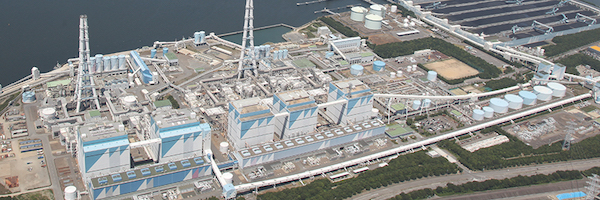Ammonia co-firing to be demonstrated at Hekinan
8 November 2021JERA and IHI have embarked on a joint project aimed at demonstrating ammonia co-firing at a large-scale commercial coal fired power plant in Japan

JERA (Tepco/Chubu Electric 50:50 joint venture) and IHI Corp. have received notice of acceptance of their joint grant application to Japan’s New Energy and Industrial Technology Development Organization to conduct an ammonia co-firing demonstration project at a large coal-fired power plant.
Ammonia – currently primarily used as agricultural fertiliser – enables efficient, low-cost transport and storage of hydrogen, the partners in the project say, and in addition to this role as an energy carrier, it can also be used directly as a fuel in thermal power generation, they note, and “as a fuel that does not emit carbon dioxide when burned, ammonia is expected to offer great advantages in reducing greenhouse gas emissions.”
In the course of the project, which will run for some four years, until March 2025, JERA and IHI plan to demonstrate an ammonia co-firing rate of 20% at the 1000 MWe unit 4 of JERA’s Hekinan coal fired power plant.
JERA has responsibility for ammonia procurement and construction of related facilities such as the storage tank and vaporiser, while IHI’s role is to develop the burners to be used in the demonstration. The two companies are “moving forward with design and construction”’ they say, and describe this “as the world’s first demonstration project in which a large amount of ammonia will be co-fired in a large-scale commercial coal-fired power plant.”
To ensure the reliability of high-volume ammonia co-firing, the two companies say they plan “to verify the necessary parameters for developing the demonstration burners” by conducting small-scale ammonia co-firing tests using burners of different materials at Hekinan unit 5 (also 1000 MWe) from August to December 2021.
Under its “JERA Zero CO2 Emissions 2050” programme, JERA is working to reduce CO2 emissions from its domestic and overseas businesses to zero by 2050, “promoting the adoption of greener fuels and pursuing thermal power that does not emit CO2 during power generation.” JERA says it will continue to contribute to energy industry decarbonisation through its own proactive efforts “while ensuring economic rationality.”
IHI is actively promoting the development of hydrogen and ammonia utilisation technologies and the establishment of supply chains and says it is offering “recycling technologies for the effective use of CO2.”
Ammonia supply chain
JERA has also recently concluded a memorandum of understanding with fertiliser producer Yara International related to co-operation in the ammonia value chain, including development of a ‘blue’ ammonia production plant (in which ammonia synthesis is combined with CCS.
Under the recently concluded memorandum of understanding, JERA and Yara have agreed to pursue potential collaboration in the following areas:
- improvements to the Yara Pilbara fertiliser plant in Australia to enable the production of low carbon (blue) ammonia;
- joint development of new blue and green (zero carbon) ammonia production projects;
- optimisation of ammonia shipping;
- development of new markets for ammonia in Japan, including in power generation, and supply of ammonia to those markets.
Yara is one of the world’s largest producers of ammonia, a global leader in ammonia sales and shipping, and is actively working to decarbonise the ammonia production process.
JERA says it expects its collaboration with Yara “to contribute to the stable supply of ammonia for power generation and to promote understanding of the supply chain.”




